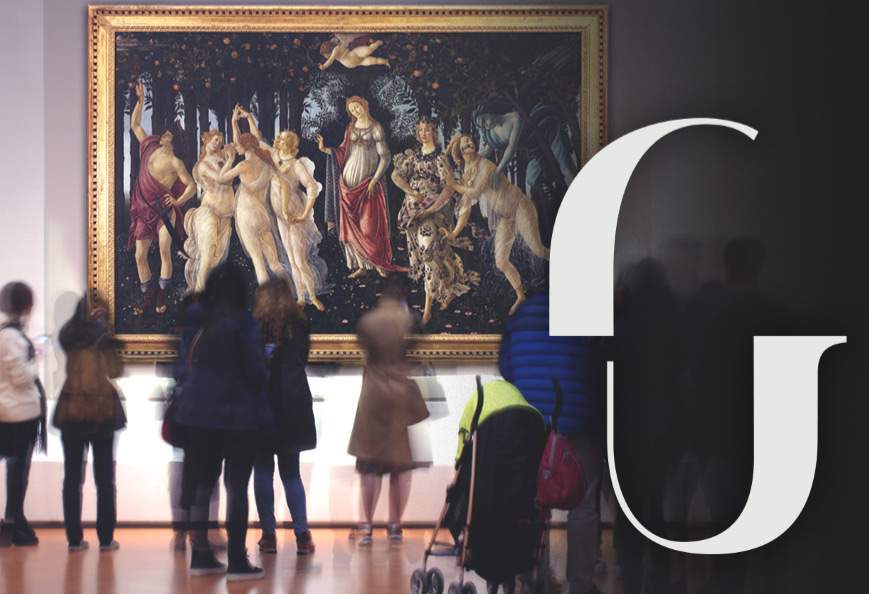2018 was a record-breaking year for the Uffizi Galleries in Florence . The museum complex, which in addition to the gallery includes the Pitti Palace and the Boboli Gardens, welcomed a total of 4,153,101 visitors compared to 3,918,350 in 2017.
Specifically, the Uffizi alone received 2,230,914 visitors (down 0.20 percent from 2017, but this is still a number that places them first in the ranking of Italian museums), Palazzo Pitti 735,390 (up 24.65 percent from 2017), and the Boboli Gardens saw 1,188,409 people (up 8.59 percent).
In monetary terms, thanks to the new ticketing with variable price according to the time of the year, the Uffizi Galleries recorded a record-breaking increase: 34,090,512 euros in revenue, an increase of 50.5 percent compared to 2017, when the complex collected €22,645,676. In this case, we are talking about 29,446,935 € earned from tickets (+62% compared to 2017), 1,277,172 € that came from the sale of photographs, publications, concessions for TV filming and spaces for special initiatives (+19.5% compared to 2017), and 918,136 € that came from donations from private individuals, while and the remainder from other sources. According to the museum, the increases are due to new installations, the inauguration of rooms such as the Caravaggio and 17th-century Michelangelo and Raphael rooms (31 new rooms in all, of which 13 were refurbished and 18 were set up from scratch), and the acquisition of as many as 64 new works (11 donations and 53 purchases). One of the new acquisitions, Daniele da Volterra’s Prophet Elijah , was also awarded “acquisition of the year” worldwide by Apollo Magazine.
Director Eike Schmidt said, “We are beginning to see the first fruits of our operation to deseasonalize tourist flows, aimed at reducing the peaks of attendance typical of spring and summer and bringing more people to the museum in the colder months of the year, and also, with a series of targeted measures, we have achieved the goal of lightening the Uffizi by attracting more visitors to the Pitti Palace and the Boboli Gardens.” In addition, the director added, “the increase in receipts has been steady and progressive since 2015, with a real boom last year thanks to the new seasonal ticket. These increased availabilities have allowed us to devote robust support to conservation activities that in some cases had not been possible to sustain for decades, and to enhancing the usability of the museums, opening new spaces or reopening ones that have been closed for a long time, as well as enabling an even stronger commitment to scientific research and educational activities.”
In fact, scientific activity was also intense in 2018, with a total of 6,566 pages of publications, distributed in 25 volumes, to which must be added another 4,496 pages of translations of texts in seven languages. Four international conferences organized, 32 lectures. Numerous were also the educational activities (881 meetings for 19,669 people, in addition to about 1,200 pupils involved in alternating school-work projects), those of accessibility and cultural mediation (173 meetings for 1,308 people), 42 performances including dance shows, theater, concerts in the spaces of the complex. Great success, finally, for the summer cinema in the Uffizi square, organized together with the City of Florence: 48 opening nights (twice as many as last year), for a total of more than 13 thousand admissions. On the Internet front, the Galleries’ new website (www.uffizi.it), launched in 2017, was visited last year by 1,371,641 individual users (3,758 per day), for a total of 7,742,450 page views (21,212 per day), with an average dwell time of 3 and a half minutes. 12 new virtual exhibitions welcomed to the web space, 42 magazine articles added to the site in 2018.
On the rise, then, are the Uffizi’s two social profiles: Instagram is at 241,541 followers (+149% compared to 2017; and the trend is still going up), qualifying as the first museum in Italy in terms of followers and engagement (user interactions) and tenth in the world, also in terms of engagement; Twitter travels at 29,499 followers (+33%), third museum in the world for engagement on this platform. Very present in media around the world, the museum complex in 2018 obtained more than 1,000 articles and reports in international media, gaining space in prestigious newspapers such as Bbc, CNN, New York Times, Wall Street Journal, Financial Times, Reuters, National Geographic, Le Figaro, El Pais, and La Nacion.
Finally, it should be noted that since 2015, for services paid for by the Uffizi Galleries, 94 new jobs have been created by Ales, the in-house company of the Ministry of Cultural Heritage: in part, these are custodian jobs, which allow a much larger number of rooms to be kept open than in the past, but specialized professionals such as lawyers, engineers, technicians and gardeners have also been recruited. Below are the top 5 most visited exhibitions:
1) Fritz Koenig. 1924-2017. The Retrospective, between the Uffizi and Boboli Gardens (21/6-7/10), 1,152,256 tickets
2) Islam and Florence. Art and Collecting from the Medici to the Twentieth Century, at the Uffizi (6/22-23/9), 660,642 tickets
3) Riding the Weather. The Art of Riding from Antiquity to the Middle Ages, in the Boboli Gardens, (6/26-14/10), 446,260 tickets
4) Nature’s Microscope Water. Leonardo da Vinci’s Codex Leicester, at the Uffizi (10/29-20/1/19) 291,398 tickets (calculation on exhibition period through 12/31/18; final total at end of exhibition on 1/20/19: 383,987 tickets)
5) Miraculous Encounters. Pontormo from drawing to painting, Palazzo Pitti (8/5-29/7), 188,229 tickets
 |
| 2018, record-breaking year for Uffizi with boom in takings: up 50 percent |
Warning: the translation into English of the original Italian article was created using automatic tools. We undertake to review all articles, but we do not guarantee the total absence of inaccuracies in the translation due to the program. You can find the original by clicking on the ITA button. If you find any mistake,please contact us.